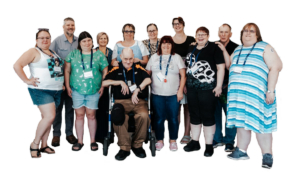Self-advocacy is an important way to empower people with disabilities to express their needs, preferences, and rights actively. Starting an advocacy group can be difficult when thinking about how to start and what to talk about. These worksheets are a resource for communicating needs, rights, and preferences. Whether for personal development, advocacy in educational settings, or navigating healthcare, a self-advocate group can build strength in numbers and empower individuals to express themselves more confidently. We want to provide this resource to help start up more advocacy groups. In this guide, you will explore self-advocacy, how to start a group and group agreements. We hope this will empower you to start your own group!
Worksheet #1: What is Self Advocacy?
Worksheet #2: How to Start an Advocacy Group
Worksheet #3: Group Agreements
Worksheet #4: Creating an Agenda
Worksheet #5: Setting Goals (Coming Soon)
Worksheet #1: What is Self-Advocacy?
Self-Advocacy
Self-advocacy is about expressing what you want for yourself and being the boss in your own life. It is about getting to know yourself, being proud and having choice and control over the things that impact your life.
It is about making your own decisions and knowing your responsibilities.
Group Advocacy
Group advocacy is when a group of people come together to:
- Learn new things.
- Solve problems.
- Find resources.
- Make a case for change.
- Ask for what you want as a group.
Group advocacy is about realizing you are not alone, and finding other people who care about the same things you do.
It’s about helping others become leaders to make positive changes in their own lives.
It’s about teamwork!
Worksheet #2: How to Start an Advocacy Group
Recipe for Success
- Two or more self-advocates motivated to make change.
- One or more allies to help. Allies are people, with or without disabilities, who support the group where needed.
- A place to meet at least once per month.
- One or more people to contact if you have questions.
- One or more people to get supplies and snacks for the meetings (snacks are important – you can’t start a revolution on an empty stomach!)
Tip: Try not to judge your success on the size of the group. It is more important to focus on what you are doing and how well you are doing it.
How to ask for help?
Talk with the person that is helping you start your group about what you think you will need help with and what you can do on your own.
Remember that this will change; having this same conversation every few meetings is important.
Getting started
Step 1: One of the first things to do is pick a name for your group.
- Activity: Make a list of possible names on a big piece of paper. Don’t decide on the same day. Give everyone time to think about it and make the choice at the next meeting.
Tip: Your name should be simple, easy to remember, and it should describe what the group is all about!
Step 2: Learn about “Group Agreements” – Worksheet #3
Step 3: Learn about how to make a Meeting Agenda – Worksheet #4
Step 4: Learn about Setting Your Goals – Worksheet #5
Step 5: Get started and have fun!
Worksheet #3: Group Agreements
When a group comes together, creating a list of rules everyone agrees to follow is important. We call these rules “group agreements” or “group rules”.
Here are some examples of group agreements:
- Only one person shares their thoughts at a time.
- No put-downs.
- No question is a silly question.
- It is okay to pass if you don’t want to contribute.
- Keep things inside the room. If someone shares something private, make sure to keep it private.
- Give everyone a chance to participate.
- If there is a disagreement, make it about the topic and not the person.
Activity: Are there more things that you think could be added to a list of group agreements?
Remember, these are rules that the group decides on together, and they are about respecting each other’s time, opinions, and feelings.
Tip: Write up your group agreements on flip chart paper and bring them to each meeting. Review them at the beginning of each meeting and make sure they work for you!
Worksheet #4: Creating an Agenda
What is an agenda?
An agenda is a list of things the group wants to talk about or get done at each meeting. Having an agenda to help your group stay on track is very important.
Here are a few things to consider when you are making your meeting agendas:
- We think it’s a good idea to start each meeting with a Land Acknowledgement as a way to honour the Indigenous people whose land your group is meeting on.
- It’s also a good idea to over the Group Agreements near the beginning of each meeting and put them on the agenda.
- Putting time limits on agenda items will help to keep things moving forward.
Creating an agenda
The agenda is usually created at the previous meeting, and people can suggest things to add to the agenda between meetings. You can end each meeting by asking what we should focus on at our next meeting.
It is good to make an agenda ahead of time because:
- The group will know what they will be doing at the next meeting.
- It gives people time to prepare for the meeting and complete the things they agreed to do between meetings.
- You can get right to work at each meeting to keep your energy high.
Sample agenda
Example Self Advocacy Group
Location: BC
Day: December 14, 2024
Time: 4 pm – 6 pm
Agenda:
4:00 pm – Everyone Arrives
4:05 pm – Land Acknowledgement
4:10 pm – Pick Your Name Activity:
- Bring up the flipchart from the last meeting.
- Give everyone one sticker.
- Ask everyone to come up and put a sticker on the name they like the best.
- The name with the most stickers is your new name!
Congratulations! You have a new name and have learned an important decision-making tool called dotmocracy.
4:30 pm – Make our Group Agreement Activity (Worksheet #4)
- Pick one or more people to lead the exercise.
- Go around the group and ask people to share their ideas.
- Ask for a volunteer or an ally to take notes on a piece of flipchart paper.
5:00 pm – What do we want to do at our next meeting?
- Make a list of the things you want to do next time you meet on a piece of flipchart paper.
- Ask for a volunteer to turn that list into the agenda for the next meeting.
5:30 pm – Social Time
5:50 pm – Closing Circle
- Bring the group back together and ask how everyone is feeling about today’s meeting.
Tips:
- The items will change, but keeping the same structure at each meeting will help the group bond and move things forward.
- Set a time between meetings for the meeting lead and the supporter to work together and ask for help, if needed.
- Make sure someone is taking notes at each meeting.
- Create a contact list with the best way to connect with each member of the group to share notes and meeting agendas.
- Keep notes on the best way to support each other during meetings and be respectful of each other.
- Keep your meeting notes short and clear.
Activity: Let’s work together to create your next three meeting agendas using this meeting template.
More worksheets to come soon!!


